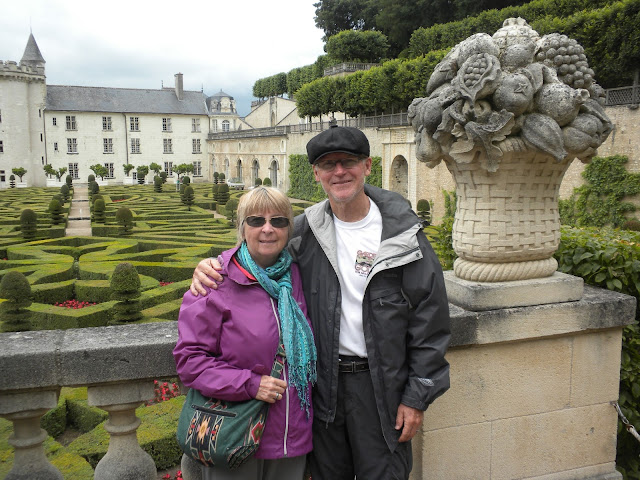Carol writes: As I was
writing the last blog on our first chateau visit at Chenonceau, Al was grinning
a little too much (at my expense) when he heard me say that I was having
trouble limiting the number of chateau pictures for my blog. We got wild and crazy and took about a
hundred pictures at each of the four chateaux we visited, so you can see my
dilemma…I will try to be a little more reasonable in this second chateau post.
Some might
think that one French chateau looks much like another, but we found that each
one seemed to have its own character, and certainly its own history and
setting, so the fascination did not lag.
CHAMBORD: What set off Château de Chambord was its immense size and its
setting in Europe’s largest enclosed forest park. Historically, Chambord was built to be used
as a hunting lodge and a winter palace for young King Francis I, necessitating
hundreds of fireplaces for its autumn contingent of hunters. It boasted over 400 rooms—80 of them open to
the public. Chambord was designed
symmetrically in the shape of a Greek cross (a cross with arms of equal length)
and was laid out with four wings of rooms with a tower at the end of each arm
of the cross around the central keep. As
we viewed Chambord from the central lane, we couldn’t believe its size or that
it was real—it resembled a fake Disney façade!
From an
architectural standpoint, one of Chambord’s most fanciful features was the
double-helix stone staircase just inside the front door. Visitors going up could see those coming
down, but they would never meet! The
ingeniousness of this design suggests that Leonardo da Vinci, who had come to
France at the request of Francis I in 1516, shortly before construction was
begun on Chambord, may have had a hand in designing the staircase.
Most of the
rooms were not furnished and instead had museum-like exhibits, labeled mostly
in French but with enough English tidbits thrown in. Some of the most interesting displays were
the knife that was used to kill King Henry IV,
a giant
clock and its equally massive gears that kept time at the chateau for over 300
years,


a stunning
collection of refurbished royal coaches,
and the
wonderfully cleaned and preserved second floor vaulted ceiling that was
designed with repetitions of the salamander, the personal emblem of Francis I,
and the letter ‘F’ (monogram for Francis).
One of the
neatest parts of the chateau was the rooftop viewing terrace which had a nice close-up
view of the high, intricately carved exterior Gothic stonework.
Often there is
a neat wartime story connected with the largest and most famous French chateaux,
and Chambord was no exception. During WW
II, its spacious chapel was used temporarily to store some of the priceless art
collections of the Louve and the Château de Versailles. The “Mona
Lisa” was stored at Chambord to keep it safe in the event Paris was bombed
by the Germans.
CHAUMONT-SUR-LOIRE: A castle has been located on the site of Chaumont-sur-Loire
since the 11th century, and the chateau you see today was built in
the 15th and 16th centuries. It has been restored and furnished in 19th
century style which, nevertheless, was very pleasing to the eye.
I found the
19th century dining room and the library especially lovely and
welcoming,
But it was
the living room at the end of the tour which caused us to stop and spend extra
time imagining after-dinner conversations and relaxation in this cozy salon.
The stables,
horse kitchen, and tack room were magnificently built in 1880s style.
VILLANDRY: Without a doubt, the best chateau gardens in the Loire valley
are found at Villandry. The chateau itself
actually
takes second seat to its incredible well-manicured gardens. There was a 10-acre Italian Renaissance love
garden impeccably maintained with symbolic hedge designs that denoted the
various kinds of love.
The kitchen
garden was filled with edible vegetables with little “rosebush trees” as a
unifying theme.
Al
particularly liked the herb garden with its lavender in full bloom.
My favorite
was the sun garden, the most recent garden and the one with some species of
perennials that were surprisingly familiar to me.
With each
chateau we visited, more than once Al and I said to each other, “No wonder
there was a French revolution.” The
over-the-top palaces and extravagant lifestyle of French royalty had certainly
gone into the stratosphere. As we left the
Loire valley and headed north to Brittany and Normandy, we felt satisfied we
had seen some of the best of the French chateau scene.
“Life is either a daring adventure or
nothing.” Helen Keller





















Beautiful! I wonder what life would have been like living there? But I still like my small townhouse.
ReplyDeleteWow, Chambord is amazing, and I can imagine more so in person. Did you find anything about the maintenance today on Chambord?
ReplyDeleteNothing in particular, but there is always something going on in the way of maintenance, cleaning of exterior stone, etc. in Europe on their majestic buildings.
ReplyDelete